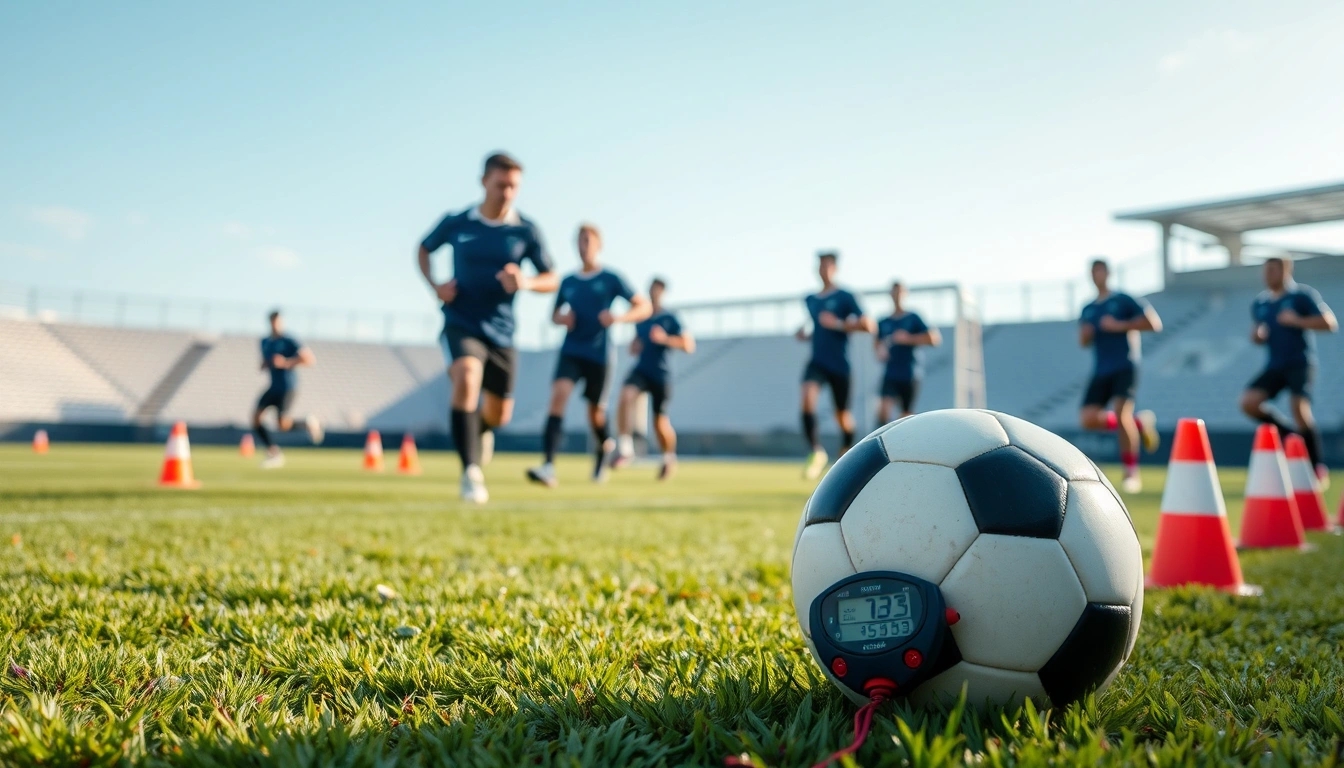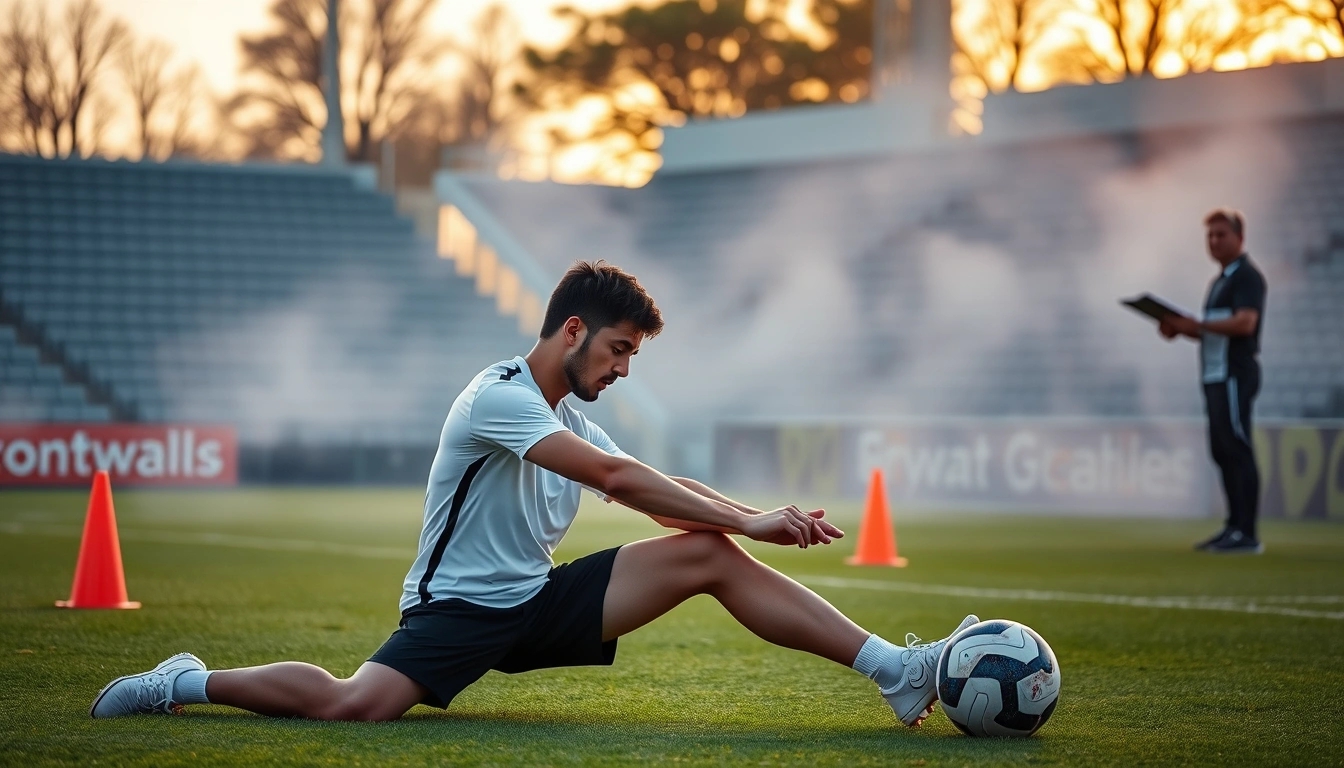Getting ready for a match isn’t just about pumping yourself up with adrenaline or shouting some motivational quotes in the locker room. Nope, the real game-changer lies in how you warm up—yes, that sometimes overlooked ritual before the whistle blows. A solid warm-up doesn’t just get your muscles loose; it primes your mind, boosts your confidence, and can seriously make or break your performance on the field. If you’ve ever shown up to a game stiff as a board and regretted it, you know exactly what I’m talking about.
Let’s be honest, warming up is often treated like a boring checkbox, but it’s actually the secret sauce for injury prevention and peak performance. Skipping it? You’re basically asking for trouble. So, what makes a warm-up routine effective? It’s a mix of dynamic stretches, sport-specific drills, and mental prep that fires up your nervous system and gets your blood flowing without draining your energy reserves.
| Component | Purpose | Example Exercises |
|---|---|---|
| Dynamic Stretches | Activate muscles, increase heart rate | Leg swings, arm circles, walking lunges |
| Sport-Specific Drills | Enhance skills & coordination | Dribbling for soccer, shooting drills for basketball |
| Mobility Work | Improve joint range of motion | Hip openers, ankle rotations |
| Mental Preparation | Focus & reduce anxiety | Visualization, breathing exercises |
Now, before you get all excited about static stretching, hold up. Static stretches—where you hold a position for a long time—are great post-game but not so much before. They can actually dull your muscle response if done too early. Dynamic stretches, on the other hand, mimic the movements you’ll use in the game and get your body ready to explode into action.
Here’s a quick rundown of some top-notch dynamic warm-up moves to try:
- High knees: Get those legs flying and heart rate up.
- Butt kicks: Loosen hamstrings and prep for sprinting.
- Walking lunges: Activate your quads and glutes.
- Arm circles: Wake up those shoulders.
- Side shuffles: Sharpen lateral movement.
Oh, and don’t forget about the mental side of warming up! Ever noticed how some players seem calm and laser-focused while others are jittery messes? That’s no accident. Incorporating breathing exercises or a quick visualization of your game plan can calm nerves and boost confidence. Trust me, your brain needs warming up just as much as your muscles.
| Mistake | Why It’s Bad | How to Fix |
|---|---|---|
| Skipping warm-up | Increases injury risk, poor performance | Commit to at least 10-15 minutes |
| Overstretching statically | Reduces muscle power temporarily | Save static stretches for cool-down |
| Warming up too long | Wastes energy, causes fatigue | Keep warm-up between 15-30 minutes |
| Ignoring sport-specific drills | Missed opportunity for skill tuning | Include drills that mimic game actions |
In short, a good warm-up routine is like a well-oiled machine—each part has a purpose and when done right, it sets you up for success. So next time you’re tempted to rush through it or skip it altogether, remember: your muscles and mind deserve that prep time. It’s not just about getting loose; it’s about getting match-ready in every sense. Now, go out there and warm up like a pro, not like someone who just rolled out of bed.
Why warming up matters
Alright, let’s cut to the chase: warming up before a match isn’t just some old-school ritual or a box to tick off on your pre-game checklist. It’s actually the unsung hero of performance, injury prevention, and mental readiness. You might’ve heard coaches drone on about it, but there’s solid science backing why it’s a total game-changer. So, buckle up, because understanding this stuff might just save you from a nasty injury or that embarrassing first-half flop.
First off, think of your muscles like a cold engine on a frosty morning. Jumping straight into full throttle? Recipe for disaster. Warming up gradually increases your muscle temperature, which makes them more elastic and responsive. This elasticity reduces the chance of strains or tears. Plus, warm muscles contract more efficiently, so you actually perform better. It’s like giving your body a heads-up that the action is about to start. No surprises. No sudden shocks.
| Benefit | Why It Matters |
|---|---|
| Injury Prevention | Increases muscle elasticity and blood flow, reducing strains and tears. |
| Muscle Activation | Prepares muscles for explosive movements and endurance. |
| Mental Focus | Sharpening concentration and reducing pre-game jitters. |
Now, let’s not forget the brain’s role here. Warming up is like a mental warm-up too. It’s your chance to shake off distractions, get into the zone, and map out your game plan. Ever noticed how some players seem laser-focused while others look like they just woke up? Well, that mental edge often comes from a solid warm-up routine that tunes the nervous system and calms those pesky butterflies.
- Boosts neural activation: Your brain and muscles start communicating better.
- Reduces anxiety: Familiar routines ease nerves and build confidence.
- Enhances reaction times: Faster responses when the whistle blows.
But hey, don’t get me wrong — warming up isn’t some magic wand. It’s gotta be done right. Too little, and you’re risking injury and sluggishness. Too much, and you might actually tire yourself out before the match even starts. Finding that sweet spot is an art and a science.
Here’s a quick checklist to keep in mind:
- Start with light aerobic activity (jogging, skipping)- Move into dynamic stretches (leg swings, arm circles)- Incorporate sport-specific drills- Keep it between 10-20 minutes depending on intensity
So, next time you’re tempted to skip the warm-up or just half-ass it, remember: this isn’t just about looking busy on the sidelines. It’s about gearing up your body and mind to crush it out there. Because when you’re warmed up, you’re not just ready — you’re unstoppable.
In summary: Warming up is a critical step that primes your muscles, prevents injuries, and sharpens your mental game. It’s the difference between starting the match like a champ or limping off the field before halftime. Don’t underestimate it — your body and brain will thank you.
Dynamic stretches vs static stretches
Dynamic stretches vs static stretches: the eternal debate that’s almost as heated as which team really deserved that last-minute penalty. When it comes to pre-match warm-ups, understanding the difference between these two stretching styles isn’t just academic – it can seriously impact how you perform on the field.
Dynamic stretches are all about movement. Think leg swings, arm circles, high knees – basically, anything that gets your muscles moving through their full range of motion without holding still. The goal? To wake up your muscles and nervous system, increase blood flow, and get your joints lubricated. It’s like telling your body, “Hey, game time is coming, better get ready!” Dynamic stretches mimic the motions you’ll use in the match, which helps your body prepare for the specific demands ahead.
On the flip side, static stretches involve holding a stretch position for an extended period, usually 15 to 60 seconds. Picture bending over to touch your toes or pulling your arm across your chest and holding it there. Static stretches are great for improving overall flexibility and cooling down after intense activity, but here’s the kicker: doing them before a match can actually reduce muscle power and explosiveness. Yeah, it’s counterintuitive, but studies have shown that static stretching right before competition can temporarily weaken muscles and slow your reaction time. Not exactly what you want when you’re about to sprint or jump.
| Aspect | Dynamic Stretches | Static Stretches |
|---|---|---|
| Purpose | Activate muscles, increase heart rate, prepare joints | Improve flexibility, cool down muscles |
| Movement | Continuous, controlled movements | Held positions, no movement |
| Best time to perform | Before matches or workouts | After exercise or during cool down |
| Effect on performance | Enhances power, speed, and agility | Can reduce muscle strength temporarily |
So why does dynamic stretching often outshine static stretching before a match? Because it’s more sport-specific and functional. It primes your body for action instead of asking it to chill out. If you’re gearing up for a soccer game, doing some dynamic lunges or butt kicks is way more useful than holding a hamstring stretch for a minute. Your muscles need to be ready to fire fast, not relax.
- Pro tip: Use dynamic stretches that mimic the movements you’ll perform in your sport. For runners, leg swings and high knees are gold. For basketball players, arm circles and walking lunges do the trick.
- Don’t ditch static stretching altogether! Save it for after the game or training session to help with recovery and flexibility improvements.
In short, if you want to feel sharp, agile, and ready to crush it, dynamic stretches should be your go-to before stepping on the pitch. Static stretches? They’re more like the post-game party – important, but not the place to start the night.
So next time you’re tempted to just casually bend over and hold that toe touch before kickoff, think twice. Your muscles might just thank you for shaking things up a bit instead.

Top 5 dynamic warm-up exercises
Alright, let’s cut to the chase: warming up isn’t just about looking busy on the sidelines or pretending to be all professional before the match kicks off. It’s about firing up those muscles, getting your blood racing, and waking up your nervous system so you don’t feel like a rusty robot when the whistle blows. Now, static stretches? Meh, save those for after the game. Pre-match, dynamic movements are where it’s at. They get everything moving, lubricate your joints, and boost your heart rate just right. So, without further ado, here’s a practical list of the top 5 dynamic warm-up exercises that actually work.
| Exercise | Description | Why It Works | Duration/Reps |
|---|---|---|---|
| Leg Swings | Stand next to a wall or partner for balance and swing one leg forward and backward, then side to side. | Loosens up hip flexors, hamstrings, and glutes while improving hip mobility. | 10-15 swings per leg |
| Walking Lunges with Torso Twist | Step forward into a lunge, then twist your torso toward the leading leg before stepping forward with the other leg. | Activates quads, hamstrings, glutes, and engages core muscles for balance and coordination. | 10 lunges each leg |
| High Knees | Jog in place lifting knees as high as possible, pumping arms vigorously. | Raises heart rate quickly and primes hip flexors and calves for explosive movement. | 30 seconds |
| Butt Kicks | Jog in place kicking heels up to touch your glutes, keeping a quick tempo. | Warms up hamstrings and improves running mechanics. | 30 seconds |
| Arm Circles | Extend arms out to sides and make controlled circles forward and backward. | Prepares shoulders and upper back for dynamic movements and prevents stiffness. | 20 seconds each direction |
Now, you might be thinking, “Is that it? Just five? Come on, coach, I want the magic sauce!” But trust me, these moves cover all the bases: lower body, upper body, cardio spike, and mobility. They’re simple, effective, and you don’t need fancy equipment or a degree in kinesiology to nail them. Plus, they don’t take forever — about 7 to 10 minutes tops, which is perfect because no one wants to be stuck warming up forever while the game’s already started.
- Pro tip: Don’t rush through these like you’re trying to escape a bad date. Controlled, deliberate movements are key. Feel the stretch, feel the activation.
- Mix it up: Depending on your sport, tweak the exercises. Soccer players might add some lateral shuffles; basketballers could throw in some quick sprints.
- Listen to your body: If something feels off or painful, back off. Warming up shouldn’t hurt.
One last nugget — dynamic warm-ups aren’t just for the pros or gym rats. Whether you’re the weekend warrior or the kid playing pickup games, these exercises prep your body like a champ. Skip them, and you’re basically asking for trouble, be it pulled muscles or sluggish reactions. So, next time you’re gearing up, remember: a good warm-up is your secret weapon. No fancy gadgets, no secret formulas, just good old-fashioned movement to get you game-ready.
The role of sport-specific drills
Look, generic warm-ups are like wearing the same pair of sneakers for every sport—you *can* do it, but should you? Absolutely not. When it comes to warming up, just jogging in place or doing some random stretches might get your blood flowing, sure, but it won’t prepare the exact muscles and skills you’re gonna need once the game kicks off. That’s where sport-specific drills come into play, and honestly, they’re a total game-changer.
Think about it: a basketball player needs quick lateral movements, explosive jumps, and sharp hand-eye coordination. Meanwhile, a soccer player’s warm-up should focus on dynamic leg swings, quick sprints, and ball touches. Doing the same warm-up for both? It’s like trying to fix a leaky faucet with a hammer—wrong tool, wrong job.
| Generic Warm-up | Sport-Specific Warm-up |
|---|---|
| Light jogging, static stretches | Drills mimicking game movements, dynamic stretches |
| General muscle activation | Targeted muscle groups used in the sport |
| Low mental engagement | Sharpens focus on sport-specific skills |
Now, here’s the kicker: sport-specific drills don’t just warm your body—they prime your brain. Imagine a tennis player practicing quick volleys or a football quarterback throwing warm-up passes. These drills fire up the neural pathways, making your reactions faster and your decisions sharper. In other words, you’re not just limbering up your limbs; you’re getting your head in the game.
- Boosts performance: Tailored drills activate the exact muscles and movement patterns you’ll use, reducing sluggishness and improving efficiency.
- Builds confidence: Rehearsing sport-specific skills before a match calms nerves and builds a winning mindset.
- Prevents injury: Properly preparing muscles and joints for the stresses of your sport lowers the risk of pulls and strains.
Of course, this doesn’t mean you toss out all traditional warm-up elements. A well-rounded routine often blends general aerobic activity with these targeted drills. But if you’re relying solely on generic warm-ups, you’re missing out big time.
Here’s a quick example for a sprinter’s warm-up:
- 5 minutes light jogging- Dynamic leg swings front-to-back and side-to-side- High knees and butt kicks- Sprint drills at 50%, 70%, and 90% effort- Quick reaction starts mimicking race conditions
See how each step builds toward the actual explosive performance needed? That’s the magic of sport-specific drills.
So next time you’re tempted to just “do some warm-ups,” think again. Tailoring your routine to fit your sport’s demands isn’t just a fancy add-on—it’s the secret sauce to performing your best and walking off the field feeling like a champ.
Incorporating mobility work
Alright, let’s get real about mobility exercises — they’re often the unsung heroes of any athlete’s warm-up, yet they don’t get the flashy spotlight like sprint drills or weightlifting. But here’s the kicker: if you want your joints to behave like well-oiled machines and your range of motion to hit those sweet spots, mobility work isn’t just important, it’s downright essential.
Think about it this way: your joints are the hinges on which your entire athletic performance swings. If those hinges are rusty, stiff, or just plain cranky, no amount of raw power or speed will save you from feeling sluggish or, worse, snapping something. Mobility exercises help lubricate these hinges by improving the flexibility and function of the muscles, tendons, and ligaments that surround your joints.
- Improved joint function: Mobility drills increase synovial fluid circulation — that’s the natural oil your joints produce. More fluid means smoother movements and less wear and tear.
- Enhanced range of motion: Stretching beyond your comfort zone (safely, of course) lets you move more freely. This means higher kicks, deeper squats, and quicker pivots.
- Injury prevention: When joints move properly, the risk of strains, sprains, and overuse injuries drops significantly.
| Exercise | Target Joint | Benefit |
|---|---|---|
| Hip Circles | Hip | Improves hip joint rotation and stability |
| Arm Swings | Shoulders | Increases shoulder flexibility and blood flow |
| Cat-Cow Stretch | Spine | Enhances spinal mobility and posture |
| Ankle Rolls | Ankles | Boosts ankle joint flexibility and balance |
Now, I’m not saying you should suddenly start doing complicated yoga poses or twist yourself into a pretzel before every game. But a solid 5-10 minute routine focusing on these mobility drills can make a world of difference. You’re basically telling your body, “Hey, loosen up, we’re about to do some serious work.” And your body listens — eventually.
Here’s a little secret from the trenches: athletes who neglect mobility work often complain about stiffness, slower recovery, and that nagging “something just doesn’t feel right” sensation. Meanwhile, those who embrace it tend to have better balance, quicker reaction times, and fewer trips to the physio.
Sample Mobility Routine (5 minutes):- 30 seconds Hip Circles (each leg)- 30 seconds Arm Swings (front to back)- 1 minute Cat-Cow Stretch- 30 seconds Ankle Rolls (each foot)- 1 minute World's Greatest Stretch (dynamic lunge with twist)
So next time you’re tempted to skip mobility exercises because they look “too easy” or “not intense enough,” remember: they’re the quiet MVPs working behind the scenes. Your joints will thank you later when you’re out there smashing personal bests instead of limping off the field.
Bottom line? Mobility work isn’t just some fluffy pre-game fad — it’s a critical piece of the puzzle that helps unlock your full athletic potential. Don’t sleep on it.

Warm-up duration: Finding the sweet spot
Alright, let’s cut to the chase—how long should a warm-up really be? Too often, athletes either rush through it like it’s a tedious chore or drag it out so long their legs feel like jelly before the game even starts. Finding that perfect timing for your warm-up is like Goldilocks hunting for the just-right porridge: not too short, not too long, but juuust right. And trust me, this isn’t just some arbitrary number tossed around by coaches; it’s a critical factor that can make or break your performance.
First off, a warm-up that’s too brief—say, less than 5 minutes—is basically like trying to start a cold car on a frosty morning. Your muscles haven’t had enough time to crank up blood flow, your heart rate stays low, and your joints remain stiff. This leaves you vulnerable to injuries and sluggish movements. On the flip side, an overly long warm-up—think 30 minutes or more—can sap your energy reserves before the whistle even blows. You might feel loose, but by kickoff, you’re already running on fumes. So, where’s the magic number?
- 5-10 minutes: Bare minimum for light activities or casual sports where intensity is low.
- 10-20 minutes: The sweet spot for most competitive sports, balancing muscle readiness and energy conservation.
- 20+ minutes: Usually reserved for endurance events or cold weather conditions where muscles need extra coaxing.
Now, don’t just blindly stick to a stopwatch. Your warm-up duration should depend on a few key factors:
| Factor | Effect on Warm-up Duration |
|---|---|
| Sport Type | High-intensity sports like soccer or basketball need longer, dynamic warm-ups. |
| Weather Conditions | Colder temps require longer warm-ups to prevent muscle stiffness. |
| Individual Fitness Level | Beginners might need more time; seasoned athletes often get ready faster. |
| Time Between Warm-up and Game | Long gaps mean shorter warm-ups or quick re-warm-ups before play. |
Here’s a little nugget for you: quality beats quantity. A focused 15-minute warm-up with dynamic stretches, mobility drills, and sport-specific movements will always outperform a lazy 30-minute shuffle around the field. And don’t forget to listen to your body—if you feel tight or sluggish, extend it a bit. If you’re sweating buckets and gasping for air, maybe dial it back.
Quick checklist for your warm-up duration:
- Start with light cardio to raise heart rate (3-5 mins)
- Move into dynamic stretches targeting your sport’s key muscles (5-10 mins)
- Finish with sport-specific drills to sharpen coordination and mental focus (5 mins)
Remember, warming up isn’t a race—it’s an investment. Nail the timing, and you’re setting yourself up for peak performance. Ignore it, and you might as well be playing with a handicap. So next time you’re tempted to skip or skimp on your warm-up, think twice. Your muscles (and your coach) will thank you.
Psychological benefits of warming up
Warming up isn’t just about getting your muscles loose or your heart rate up; it’s like a mental boot camp before the real battle begins. You might think, “Eh, I’m just gonna jump in and figure it out,” but trust me, your brain doesn’t work that way. The warm-up phase is a secret weapon for sharpening your mind, easing those pesky nerves, and locking in focus like a laser beam on the task ahead.
Let’s be real — anxiety before a match can be a real pain in the neck. You’re standing there, heart pounding, palms sweaty, and your thoughts are racing faster than a sprinter out of the blocks. A well-structured warm-up helps dial down that mental chaos. It’s like giving your brain a gentle nudge to switch from “panic mode” to “game mode.” This transition is crucial because when your mind is calm and collected, your performance skyrockets.
- Focus sharpening: Warming up activates your brain’s motor cortex, the area responsible for movement planning and execution. This means your brain and body start syncing up, reducing reaction times and improving coordination.
- Reducing anxiety: The repetitive, rhythmic actions during warm-ups trigger the release of endorphins — your body’s natural feel-good chemicals. This biochemical boost helps knock down stress levels, so you feel more confident stepping onto the field.
- Mindfulness and presence: The warm-up period is a mini mental rehearsal. You get to visualize plays, anticipate moves, and mentally prepare for different scenarios. This mental prep primes your brain for quick decision-making once the whistle blows.
| Psychological Benefit | How Warm-Up Helps | Practical Tip |
|---|---|---|
| Focus & Concentration | Engages motor cortex and neural pathways | Include sport-specific drills during warm-up |
| Anxiety Reduction | Endorphin release lowers stress hormones | Incorporate steady, rhythmic movements |
| Mental Rehearsal | Visualizes scenarios and strategies | Spend a few minutes on visualization exercises |
Now, don’t get me wrong — warming up won’t magically erase all your pre-game jitters. But it sure makes them manageable. Think of it like tuning a guitar before a gig; you don’t want to start playing when the strings are all off. The same goes for your brain. If you dive in cold, you’re more likely to fumble, hesitate, or just plain freeze under pressure.
Also, there’s this sneaky benefit that doesn’t get talked about enough: confidence. When you’ve warmed up properly, you feel ready. Your body feels alive, your mind is alert, and suddenly, you’re not just hoping for a good game — you’re expecting it. This subtle shift in mindset can be a game-changer.
So next time you’re tempted to skip the warm-up because “it’s boring” or “you’re already pumped,” think twice. That few extra minutes spent warming your muscles and your mind might be the difference between an average game and a performance you’ll brag about for weeks.
Quick warm-up mental checklist:- Breathe deeply to calm nerves- Perform dynamic movements to engage brain-body connection- Visualize key plays or strategies- Keep your focus on the present moment, not the scoreboard
In conclusion, warming up is as much a mental ritual as it is a physical one. It’s where your brain gets the memo: “Game on!” And when your mind and body are both tuned up, you’re not just playing — you’re competing at your best. So don’t just warm up your body, warm up your brain too. It’s worth every second.
Common warm-up mistakes to avoid
When it comes to warming up before a match, you’d think it’s straightforward — just get moving, right? Well, not quite. A lot of athletes, from weekend warriors to seasoned pros, trip up on some pretty common errors that seriously sabotage their warm-up’s effectiveness. And honestly, these slip-ups can be the difference between feeling ready or limping through the first half. Let’s get into the nitty-gritty of what to watch out for and how to fix it.
1. Skipping the warm-up altogether or rushing through it
Look, I get it — sometimes you’re late, or you just wanna save your energy for the game. But blasting into full effort without prepping your body is like trying to start a car in subzero weather without warming the engine. Your muscles stay stiff, your heart rate jumps too fast, and boom — injury risk skyrockets. Aim for at least 10-15 minutes of gradual movement, not a mad dash.
2. Overdoing static stretches before activity
Static stretching — holding a stretch for 20-30 seconds — has its place, but right before a game? Not so much. Studies show it can actually reduce muscle power and explosiveness. Instead, dynamic stretches like leg swings or arm circles are the way to go. They get your blood flowing and muscles firing without the sluggishness.
| Mistake | Why it’s bad | Better approach |
|---|---|---|
| Skipping warm-up | Increases injury risk and reduces performance | Spend 10-15 minutes on gradual dynamic movements |
| Excessive static stretching | Decreases muscle power and readiness | Use dynamic stretches to activate muscles |
| Ignoring sport-specific drills | Less neuromuscular coordination for game movements | Include drills mimicking match actions |
| Warming up too long | Can cause fatigue before game starts | Keep warm-up within 20 minutes max |
3. Neglecting sport-specific warm-up elements
Generic warm-ups are fine, but if you’re a soccer player and you spend your warm-up just jogging and stretching, you’re missing out. Your body needs to rehearse the actual movements you’ll use in the game — quick cuts, sprints, ball touches. Otherwise, your muscles and brain aren’t quite synced when the whistle blows.
4. Forgetting to gradually increase intensity
Jumping straight into high-intensity drills without easing in is a rookie move. Your heart and muscles need to warm up progressively — starting slow and building up. Otherwise, you risk pulling something or just feeling gassed before kickoff.
- Tip: Start with light jogging, then add dynamic stretches, then sport-specific drills, and finally some short sprints or explosive moves.
- Don’t: Blast off at 100% right away.
5. Ignoring mental preparation
Warming up isn’t just physical. If your mind’s wandering or you’re stressing about that last-minute lineup change, you won’t perform your best. Use your warm-up time to focus, visualize, and get in the zone. It’s like tuning a radio — you want your brain signal crystal clear.
So yeah, the warm-up isn’t just a “meh” pre-game ritual. It’s a vital process that, when done right, primes your body and mind for battle. Avoid these common mistakes, and you’ll not only cut down injury chances but also boost your game-day mojo. Remember: the devil’s in the details, and a sloppy warm-up is a fast track to a sloppy performance.
Quick checklist before your next match:
- Allocate 10-15 minutes for warm-up
- Focus on dynamic, not static stretches
- Include drills specific to your sport
- Gradually increase intensity
- Mental focus is part of the routine
Keep these in mind, and your warm-up will be more than just a formality — it’ll be your secret weapon.

Sample warm-up routine for soccer players
Okay, so you’re about to hit the pitch and you think, “Eh, maybe I’ll just jog a bit and call it a day.” Hold up! Soccer isn’t just a casual stroll; it demands your body to be sharp, agile, and ready to explode into action. A proper warm-up isn’t just some boring ritual – it’s your secret weapon to avoid pulling a hammy or looking like a lost puppy chasing the ball. Let’s break down a step-by-step warm-up plan that’s actually worth your time before match day.
- Step 1: Light Jogging (5 minutes) – Nothing fancy here. Just a slow jog around the field to get your heart rate ticking up. This wakes up your cardiovascular system and gently nudges your muscles out of their slumber.
- Step 2: Dynamic Stretching (7 minutes) – Now, don’t go holding static stretches like a statue. We’re talking leg swings, walking lunges, high knees, and butt kicks. These moves mimic the game’s demands and crank up your muscle elasticity.
| Dynamic Stretch | Reps | Purpose |
|---|---|---|
| Leg swings (front to back) | 10 each leg | Loosens hip flexors and hamstrings |
| Walking lunges | 12 steps | Activates quads and glutes |
| High knees | 20 meters | Boosts hip mobility and coordination |
| Butt kicks | 20 meters | Preps hamstrings for sprinting |
- Step 3: Sport-Specific Drills (8 minutes) – This is where you get real. Incorporate dribbling, short sprints, and quick directional changes. Your brain and muscles start syncing up for the chaos of the game.
- Step 4: Mobility Work (5 minutes) – Focus on ankle circles, hip rotations, and knee hugs. These exercises improve joint function, which is crucial when you’re twisting and turning like a maniac chasing the ball.
Sample Mobility Routine:- Ankle circles: 10 each side- Hip openers: 10 each leg- Knee hugs: 10 each leg
Now, don’t overdo it. The sweet spot for a warm-up is roughly 20-25 minutes. Too short? You’re risking injury and sluggishness. Too long? You’re draining precious energy before kickoff. Also, remember to keep your mind in the game. Use this time to visualize plays, get hyped, or just breathe and calm those nerves.
Lastly, a quick tip: if it’s freezing cold or blazing hot, tweak your warm-up accordingly. Cold weather means longer warm-ups to prevent muscle stiffness; hot weather calls for hydration breaks and lighter intensity to avoid overheating.
So next time you’re tempted to skip the warm-up, think twice. This routine isn’t just a checklist – it’s your ticket to playing smarter, faster, and with less chance of sitting out on the sidelines nursing an injury. Lace up, warm up, and own that pitch!
How to adjust warm-ups for different weather conditions
When the thermometer takes a nosedive or the sun decides to crank up the heat, your usual warm-up routine might just throw you a curveball. You can’t treat a freezing morning the same way as a scorching afternoon, no matter how much you love your drills. So, how do you tweak your warm-ups to stay safe, sharp, and ready to roll? Let’s break it down.
Cold Weather Warm-Up Tips
Cold days can be brutal on your muscles and joints. They tighten up faster than you can say “ouch,” and that’s a recipe for injury if you don’t adjust. First off, extend your warm-up duration. Instead of the usual 10 minutes, push it to 15 or even 20. Your body needs more time to raise its core temperature.
- Layer smart: Start with a moisture-wicking base layer, add a thermal mid-layer, and top it off with a windproof jacket. You want to trap heat but still be able to shed layers as you warm up.
- Dynamic movements: Stick with dynamic stretches and light jogging to get blood flowing. Avoid static stretches early on—they’re better saved for later when your muscles are nice and warm.
- Focus on extremities: Hands, feet, and neck get cold first. Use gloves, warm socks, and maybe a beanie during warm-up to keep those parts happy.
Hot Weather Warm-Up Tips
When it’s blazing hot, the challenge flips. Your body is already sweating buckets before you even start, so the goal is to warm-up without overheating. It’s a tightrope walk between getting ready and not frying yourself.
- Hydrate early and often: Don’t wait until you’re parched. Drink water before, during, and after warm-up to keep your system cool and functioning.
- Shorten warm-ups: Cut down the duration to 5-10 minutes. Focus on lighter aerobic activities and skip anything that feels like a marathon.
- Choose the right time: If you have flexibility, warm up during cooler parts of the day like early morning or late afternoon.
- Wear breathable gear: Lightweight, loose-fitting clothes that wick sweat away are your best friends here.
| Condition | Warm-Up Duration | Clothing | Focus |
|---|---|---|---|
| Freezing Cold | 15-20 minutes | Layered, insulated | Dynamic movements, extremities |
| Blazing Hot | 5-10 minutes | Light, breathable | Hydration, light aerobic |
Now, a quick heads-up: don’t just blindly follow these tips. Your body is the ultimate referee here. If you feel dizzy, shivery, or just plain off, pause and reassess. Sometimes, the best warm-up is knowing when to take it easy or even skip a step.
Pro tip: Consider adding a gentle cool-down after your warm-up on hot days to avoid sudden temperature spikes in your body. And on cold days, keep moving between drills to prevent that nasty chill from sneaking back in.
In the end, adapting your warm-up to the weather isn’t just about comfort—it’s about staying injury-free and performing at your best regardless of what Mother Nature throws at you. So next time you step out into the cold or heat, remember: a little tweak goes a long way.
Warm-up gear and equipment essentials
Alright, so you’ve nailed your warm-up routine, but have you ever stopped to think about what you’re actually wearing or bringing along to the field? Believe me, it’s not just about looking cool or flashy. The right gear can seriously boost your warm-up efficiency and keep you comfortable while you’re getting those muscles loose and ready to explode into action. Let’s break it down, no fluff.
First off, clothing is your frontline. You want layers, but not the kind that make you feel like you’re wrapped in a sleeping bag. Think lightweight, breathable fabrics that wick sweat away — cotton is a no-go here, unless you want your shirt to double as a sponge. Compression wear? Yeah, it’s not just a fad. It helps with blood circulation and muscle support, which might just save you from that annoying cramp halfway through the game.
- Base layer: Moisture-wicking shirt
- Mid layer: Light fleece or a long sleeve for chillier days
- Outer layer: Windbreaker or something water-resistant if the weather’s playing games
Footwear, folks, is another beast. Your warm-up kicks don’t have to be your game shoes, but they should feel supportive and give you decent grip. Nothing worse than slipping during high knees or lunges. And if you’re outdoors, keep an eye on the cleats — not too worn out, or you’re begging for a slip-up.
Now, onto equipment. You don’t need to haul a gym bag full of gear, but a few essentials can make a world of difference:
| Item | Purpose | Why it matters |
|---|---|---|
| Resistance bands | Muscle activation & mobility | Great for warming up smaller muscle groups and improving joint stability |
| Foam roller | Myofascial release | Helps relieve muscle tightness and improve blood flow pre-match |
| Jump rope | Cardio & coordination | Quick way to get your heart rate up and sharpen footwork |
| Water bottle | Hydration | Staying hydrated is basic but often overlooked — don’t be that guy gasping for air! |
Oh! And don’t forget the sunscreen if you’re out in the open for a while. Nothing ruins a good warm-up like a sunburn that makes you look like a lobster in the locker room.
One last nugget: avoid over-layering. It’s tempting to pile on clothes when it’s cold, but too much can lead to overheating once your body kicks into gear. You want to feel warm, not like you’re in a sauna.
So, next time you’re packing your bag or picking out your warm-up outfit, remember: it’s not just about looking sharp but feeling sharp. The right gear sets the tone for your entire pre-match prep, making sure you’re comfortable, mobile, and ready to crush it once the whistle blows.
Gear up smart, warm up smarter.

When to skip or modify your warm-up
Look, warm-ups are sacred in the sports world — they’re like the pre-game ritual that gets your engine humming. But sometimes, life throws a curveball, and sticking to your usual routine just ain’t gonna cut it. Whether you’re nursing an injury, dragging from fatigue, or caught in the chaos of back-to-back games, knowing when and how to tweak your warm-up is key to staying in the game without tanking your body.
Injury is the obvious game changer. If you’re dealing with a niggle or a fresh ache, jumping into your full, intense warm-up might do more harm than good. Instead, dial it down. Focus on gentle mobility work and light dynamic movements that get blood flowing but don’t aggravate the problem. Think of it like giving your body a friendly nudge, not a slap in the face. For example, if you’ve got a sore hamstring, skip the explosive sprint drills and opt for controlled leg swings or hip circles.
| Situation | Warm-up Modification | Why? |
|---|---|---|
| Injury (e.g., sprain, strain) | Low-impact mobility, light dynamic stretches | Prevent worsening injury, promote blood flow |
| Fatigue (after intense training) | Shortened warm-up, focus on activation, avoid heavy cardio | Conserve energy, avoid burnout |
| Back-to-back games | Brief warm-up, emphasize mental prep and light movement | Maintain readiness without excessive fatigue |
Now, fatigue — oh boy, this one’s sneaky. After a brutal training session or a long day, your body might scream “nope” to a full warm-up. Pushing through a standard routine when you’re dead tired can backfire big time, increasing injury risk or just making you sluggish. Instead, trim the warm-up down to the essentials: light activation exercises that wake up your muscles without draining your already low reserves. Think of it as a coffee shot for your legs — quick and effective.
And then there’s the dreaded back-to-back game scenario. We all know the drill: you’re barely off the field from one match and the clock’s ticking down to the next. Here, the warm-up’s gotta be smart, not long. Focus on brief, targeted movements that keep your body loose and your mind sharp. This isn’t the time for a full-blown sweat session; it’s more about maintaining readiness and preventing stiffness. Mental prep, visualization, and some light jogging or dynamic stretches will do the trick.
- Pro tip: Always listen to your body. If something feels off during your warm-up, don’t push through blindly.
- Keep a few alternative warm-up drills handy for days when energy or health isn’t at 100%.
- Communicate with your coach or physio — they might have insights tailored to your current condition.
To wrap it up, skipping or modifying your warm-up isn’t about slacking off; it’s about being smart and respecting your body’s signals. The ultimate goal? Show up ready to perform, not sidelined by preventable setbacks. So next time you feel that twinge or exhaustion creeping in, remember: it’s totally okay to change gears. Your body will thank you — eventually.
Summary table: When to adapt your warm-up
| Condition | Adaptation | Key Focus ||--------------------|--------------------------------|-------------------------|| Injury | Gentle, low-impact movements | Avoid aggravation || Fatigue | Short, activation-based warm-up | Save energy || Back-to-back games | Brief, dynamic & mental prep | Maintain readiness |
And hey, if you ever feel like skipping the warm-up entirely — maybe after a long day or a tough injury — just remember: it’s a calculated risk, not laziness. Sometimes, less really is more.
Frequently Asked Questions (The title must be written in English.)
- Why is warming up before a match so important?
Warming up is like priming a high-performance engine—it gets your muscles loose, your heart rate up, and your brain focused. Without it, you risk injuries and poor performance because your body isn’t ready to handle the intense physical demands of the game.
- Should I do dynamic or static stretches before playing?
Dynamic stretches are the MVP before matches because they mimic game movements and increase blood flow. Static stretches are better saved for after the game to improve flexibility without reducing muscle power during play.
- How long should a warm-up last?
The sweet spot is usually between 10 to 20 minutes. Too short, and you might not fully prepare your body; too long, and you risk draining energy before the match even starts.
- Can I use the same warm-up routine for every sport?
Not really! Sport-specific drills tailor your warm-up to the unique demands of your game, boosting your confidence and performance. Generic warm-ups just don’t cut it when you need precision and agility.
- What are some common warm-up mistakes to avoid?
Skipping warm-up, doing only static stretches, warming up too fast or too slow, and ignoring mental preparation are classic blunders. These can lead to injury or poor focus during the match.
- How should I adjust my warm-up in extreme weather?
In cold weather, extend your warm-up to keep muscles warm and flexible. In hot weather, shorten it and focus on hydration to avoid fatigue or heat stress. Always listen to your body’s signals.
- Is it okay to skip warm-ups if I’m tired or injured?
It’s better to modify rather than skip. Light mobility work or gentle dynamic stretches can keep you moving without risking further injury. Rest when necessary, but don’t neglect warming up completely.
- What gear should I use during warm-ups?
Wear comfortable, breathable clothing and sport-appropriate shoes. Some athletes like resistance bands or foam rollers to enhance mobility and muscle activation during warm-ups.
- Can warming up help with mental focus?
Absolutely! A good warm-up acts like a mental switch, reducing anxiety and sharpening your concentration. It’s not just your body getting ready—your brain is too.












